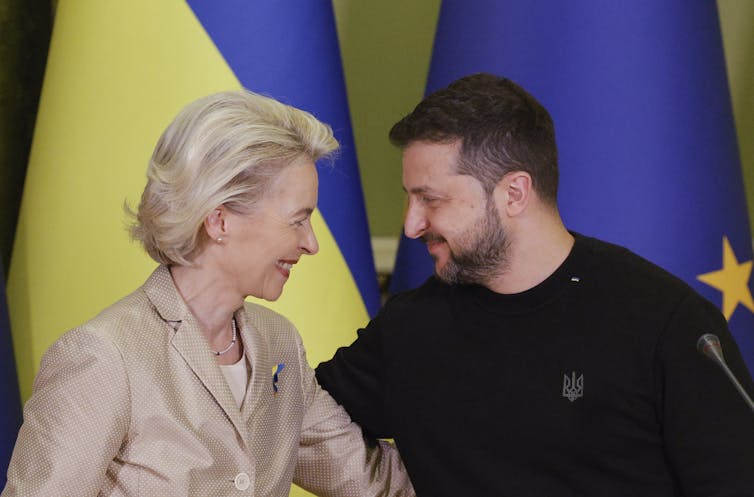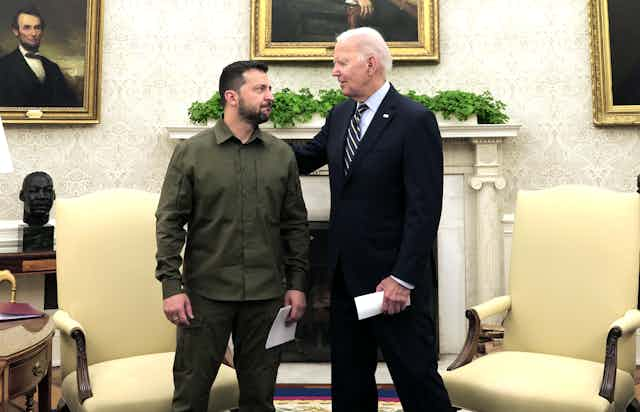More than 20 months into the war in Ukraine and over five months into Ukraine’s latest counteroffensive, the situation on the front is bleak and no breakthrough imminent, the country’s commander-in-chief admitted in a recent interview with the Economist.
With doubts increasing over the sustainability of western aid to Ukraine amid a shift of attention to the war in the Middle East, continuing Russian air strikes across Ukraine as far as the western city of Lviv do not bode well for the winter ahead.
Little wonder then that there are apparently new efforts underway to push Ukraine towards negotiations with Russia. This is unlikely to lead to actual talks between Moscow and Kyiv for now, but calls to end the war at the negotiation table will not go away. Both Kyiv and its western allies need a clearer vision of an endgame.
Domestically, Zelensky has no incentives to enter into negotiations with Russia at the moment. As he is apparently considering elections next spring, the Ukrainian president will keep an eye on public opinion polls in Ukraine.
According to a survey published in October 2023, the overwhelming majority of Ukrainians are opposed to making any territorial concessions to Russia, even if this means a longer and costlier war. This is the case across all sections of the population. Even among Russian speakers, 65% said they rejected a compromise that involved trading Ukrainian territory for peace, as did people living close to the frontlines in the east (73%) and south (74%) of the country.
Challengers of Zelensky for the presidency, such as his former adviser Oleksiy Arestovich, right now stand little chance of advancing their prospects of defeating the incumbent president in elections if they push for negotiations.
However, this might change over the coming months. First, Ukrainians’ support for Zelensky’s course of no concessions to Russia is predicated on at least the maintenance of the status quo, which is far from certain. The Ukrainian counteroffensive has made few gains over the past several months.
Meanwhile, the Russian onslaught on Avdiivka in eastern Ukraine has made steady progress. Russian forces are likely to capture the city – despite the enormous human cost of the operation – like they did Bakhmut and Soledar before.
On the political front, the absence of China from the recent meeting in Malta on Zelensky’s ten-point peace plan represents a significant blow to efforts to convene an international peace conference on Ukraine’s terms. Significantly, China participated in a similar gathering in Jeddah as recently as August.
Doubts over international support
Second, maintaining the status quo depends heavily on continuing western military, economic and political support. This cannot be taken for granted, especially in the US. In May 2022, the then Democrat-led House of Representatives passed a US$40 billion (£32 billion) support bill with 368 votes to just 57 opposing. In September this year, a US$300 million bill was also approved, but with more than twice the no votes (117).
Now, the Republican-majority House has passed a bill excluding aid for Ukraine, which is unlikely to succeed in the Democrat-led Senate and will probably be vetoed by the US president, Joe Biden.
The stalemate over aid to Ukraine in the US is particularly problematic as the last US$425 million from the US$18 billion Ukraine Security Assistance Initiative has now been committed. Given the contentious nature of US politics, aid to Ukraine will be a political football to be kicked around between the House, Senate and White House. As the US heads into an election year, this is likely to get worse, not better.
In Europe, the situation is only slightly better. The Italian prime minister, Georgia Meloni, admitted to widespread “Ukraine fatigue” in a prank call with two Russian comedians in which she thought she was speaking with officials with the African Union.
As EU leaders debated their next four-year budget at the end of October in Brussels, Hungary and Slovakia both opposed more aid for Ukraine. Meanwhile, EU Commission president Ursula von der Leyen has expressed continuing support for Ukraine.

This includes a proposal for the opening of accession talks on the country’s EU membership, likely to be agreed by EU leaders at a summit in December, subject to a favourable assessment by the commission.
While the EU can provide Zelensky with political support in the form of opening accession talks and keep Ukraine financially afloat, its €5bn (£4.3bn) military aid package pales in comparison to US support hitherto.
Uncertain outcome
There is a third issue which illustrates the pressure on Zelensky. He may have swiftly denied that he is under pressure to contemplate negotiations with Russia and one of his officials reprimanded Zaluzhny for his comments in the Economist.
But he has yet to demonstrate that his political and military strategy will achieve their aim of restoring Ukraine’s sovereignty and territorial integrity in full.
How long this window of opportunity will remain open for Zelensky, will significantly depend on the level of western support over the coming months. Even if western countries are disillusioned after 20 months of war, they must continue, and arguably increase, their support for Ukraine.
The likely alternative to this is no longer simply a stalemate on the ground. Withdrawing support brings with it the very real possibility of a Ukrainian defeat on the battlefield and a subsequent humiliation at the negotiation table.

